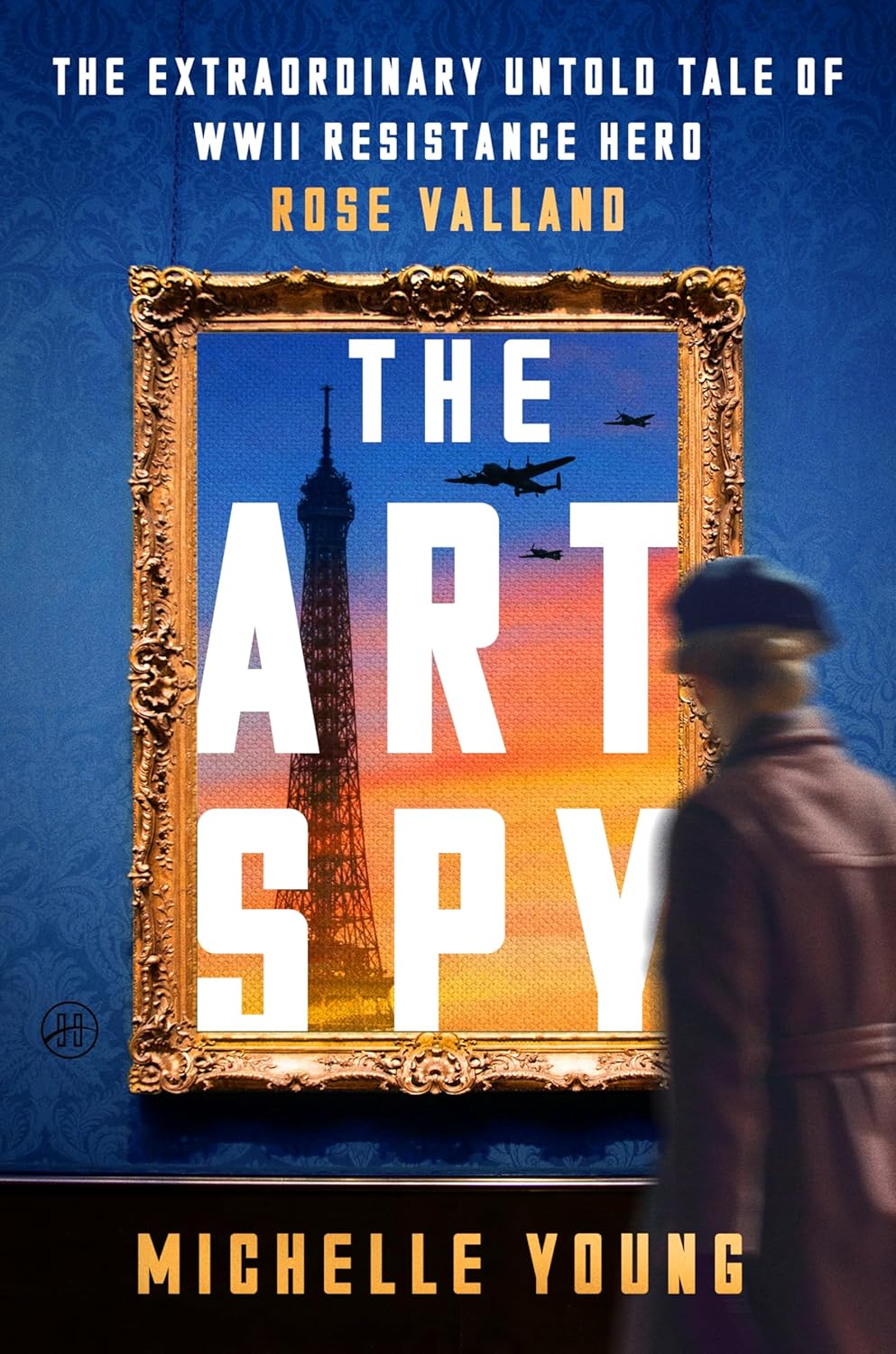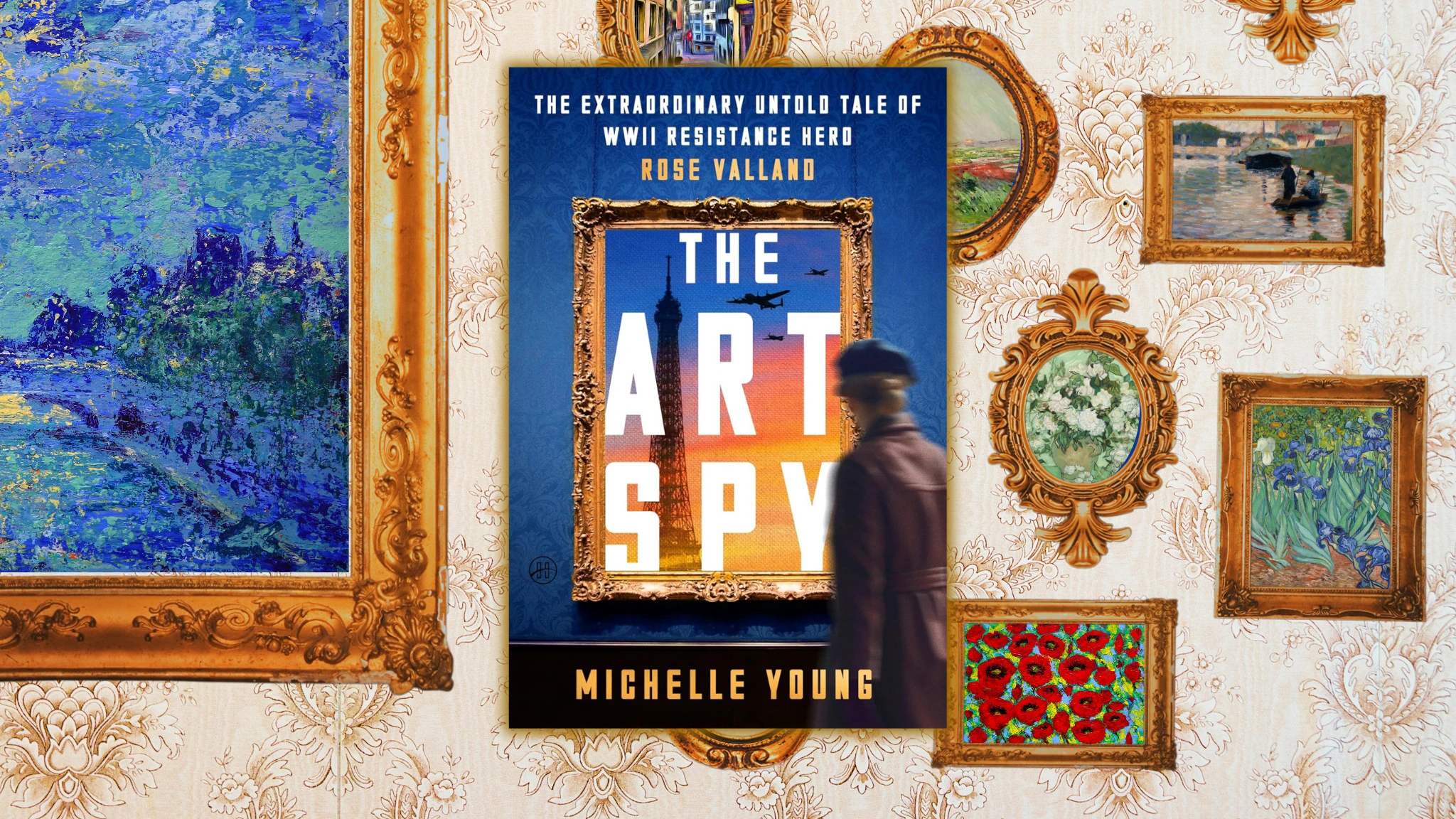The Art Spy by Michelle Young
The Art Spy subtitled The Extraordinary Untold Tale of WWII Resistance Hero Rose Valland is the result of four years of dedicated, immersive research by award-winning journalist, author, photographer, Columbia University Adjunct Professor of Architecture and frequent contributor to televised documentaries Michelle Young.
There is nothing superficial about this extraordinary work of non-fiction for which the author has delved into previously undiscovered historical documents. They reveal, among other things, the great personal risks the quiet, deceptively unassuming and highly observant museum curator Rose Valland took to preserve some of the most-renowned art treasures of the world. Her courageous risk-taking in surreptitiously accumulating information from the Nazi occupiers and passing it on to two French Resistance groups placed her in mortal danger on a daily basis.
The Forgotten Hero Behind the Monuments Men
History well remembers the Monuments Men but Rose Valland who greatly assisted their efforts has slipped into the shadows despite being one of the most decorated women of WWII. After the war, she received the United States Medal of Freedom, several medals from France including the lofty Legion d’Honneur and one for Resistance, and from Germany the Officer’s Cross of the Order of Merit for tireless efforts for justice in returning stolen art to the rightful owners.
Rose Valland (1898-1980) was formally well educated, eventually earning a doctorate in the arts, yet her impressive academic credentials were insufficient to convince the Director of the Jeu du Paume Museum to provide her a salary when she joined the staff as a “volunteer” in 1932. Dedicated to her work, her meager income came from lectures and written articles.
When Nazi wholesale looting began, Director of the French National Museums Jacques Jaujard appointed her the salaried position as Assistant Curator with additional instructions to spy on the Germans. It wasn’t until 1952; at long last, she received the title of Curator for the French National Museums. In 1954, Mme. Valland was named the director of SPOA, Service for the Protection of Works of Art. Her well-received memoir Le front de l’art (1961) was loosely adapted for the screen three years later as The Train memorably starring Burt Lancaster. Rose officially retired in 1968 but actively continued her reparation efforts until her death.
In early 1940, the Nazis converted the Jeu de Paume Museum into their Paris headquarters as a sorting and clearing house for the task force Einsatzstab Reichleiter Rosenberg known as the ERR. This looting organization was created to process and determine storage or distribution of incoming plunder: paintings, sculptures, tapestries, rare books and other works of art and antiquities systematically stolen from museums, private French collectors, and art dealers nominally on behalf of the Third Reich.
Over 600,000 works of art were stolen during the course of WWII of which approximately 100,000 passed through this museum. Initially these organized thefts targeted the wealthiest Jewish families, Masons and designated enemies of the state under the direct orders of Otto von Ribbentrop, head of the German Foreign Office in Paris. Later, in a secondary euphemistically titled “furnishings action”, they seized the possessions of approximately 70,000 Jewish families who were dislocated or transported to extermination camps.
A Museum Turned Headquarters of Plunder
When this occurred, the museum additionally became one of several collection points for fine furniture and household goods, furs, clothing and jewelry stolen from mansions, bank vaults, ordinary homes and apartments as well as supposedly secure hiding places. The worldly goods of tremendously wealthy families such as members of the Rothschilds, Seligmanns, Wildensteins, Kanns and Rosenbergs filled several trainloads.
Some of their planned storage places were revealed by bribes or failing that, the torture of trusted employees. Mr. Rosenberg’s upscale gallery represented impressionist and post-impressionist works considered by the Germans as degenerate art which could be either sold to help fund the German war effort or simply destroyed.
The loot was meticulously inventoried with many works photographed before shipment to secret storage facilities including caves and mountain tunnels in anticipation of inclusion in a magnificent post-war Führer Museum. Rare books, manuscripts and archives were designated for a central library akin to our Library of Congress. A significant portion of the spoils routinely made its way into the hands of Nazis from the highest level down to guards pilfering jewelry, clothing and furs for wives and girlfriends.
Looted Lives, Stolen Legacies
Reichsmarschall Hermann Göring, Hitler’s second-in-command, who amassed a vast collection of plunder, boasted he owned the largest private art collection in Europe. Adolf Hitler made but a single trip to Paris with a tour that lasted less than 3 hours, while Göring made 21 trips to the French capital between November 1940-November, 1942. He stayed in a Ritz Hotel suite equipped with an extra-large bathtub custom made to accommodate his considerable girth.
Ostensibly he was selecting art for Adolf Hitler and the planned museum but in actuality spent hours earmarking important pieces for his private collection that would accompany his return to Germany. Often he would take several works of the “degenerate art” of Matisse, Chagall, Picasso and others to bargain for works of the Old Masters and especially the Centerpiece of the Altar of Ghent which he fervently desired.
Additionally, he did not squander the opportunity to browse through the jewelry collections. It was noted he was partial to emeralds and would jiggle unset gems belonging to the Rothschild’s in his pockets while gazing at the works of art.
Reichsmarschall Göring was aided and abetted by Bruno Lohse, his personal representative at the Jeu de Paume. Lohse was a cultured, well-educated, multi-lingual gentleman, former art dealer in Germany with a Ph.D. in art history, an early member of the Nazi Party and a high ranking officer (SS-Hauptsturmführer) in the Luftwaffe, hand-picked for this cushy assignment by his mentor Göring.
In return, he staged full-scale exhibitions of looted art, often with only a 24-48 hour notice to the harried guards and sparse French museum staff, to present to his leader. During these two years, about 600 significant pieces were added to Göring’s personal collection rather than being destined for the planned Führermuseum in Linz. Lohse and Rose Valland frequently clashed, and all the while she discreetly eavesdropped and made notes about these visits and the transfer of artworks out of the facility. Rose witnessed as Lohse loaded his own car with fine art and other treasures that were not listed on inventory sheets.
Post-war, she was one of several people to testify against him in a two month investigation but having charmed his American captors, Lohse was found not guilty of crimes that might have resulted in a death sentence. The suicide of ERR Paris Chief Baron Kurt von Behr conveniently allowed him to place blame for irregularities in the confiscation of art collections squarely at the feet of the dead man.
Göring’s Greed and a Spy in Plain Sight
Lohse purposefully cooperated with the Americans and testified about the systematic seizure of French art at the Nuremberg Trials, condemning the role of others in the massive looting while proclaiming his personal distaste for it. He was a glib and convincing prevaricator who successfully bamboozled the American legal team. Ultimately he was acquitted by a military tribunal in Paris in 1950. This unrepentant Nazi did concede he possessed some furniture stolen from deported Jews.
In the mid-1950’s he illegally resumed his profession as an art dealer in Munich. What is perhaps more heinous given his leadership role in looting of art treasures from thousands of Jews who not only lost their possessions but all too often their lives, Lohse had the temerity to join in with German art gallery owners seeking restitution for artworks purportedly lost during the war. He claimed the worth of his personal art collection that went missing was valued in the millions of dollars!
Despite Rose Valland’s best efforts and concrete evidence, Bruno Lohse thrived until his death in 2007. He established and maintained a cordial relationship through letters and personal visits with Monuments Man Theodore Rousseau, a Metropolitan Museum of Art curator after the war.
Thus, it may have been a great revelation when his apartment and his late mother’s home were discovered to contain a large number of looted artworks. His safe and secret Swiss bank vault contained paintings by Pissarro, Renoir, Monet and others along with documents listing at least 14 sales of plundered art through European galleries and auction houses. Lohse did have a sardonic last laugh by malignantly expressing regret that he had “saved Rose Valland from a Nazi execution order.”
Much of the modern art seized from museums in Germany deemed ‘unworthy’ and ‘degenerate’ along with other looted plunder was ordered sold by Reichsminister of Propaganda Joseph Goebbels to fund the war effort. Characteristically, a portion of these funds were diverted to benefit the insatiable Göring.
In 1939, nearly 4000 of these works of art were burned in Berlin. Some of the Nazi troops assigned to transport and guard the art works from The Louvre and Jeu de Paume were less than respectful, willfully shattering frames, stepping on, damaging or destroying paintings.
Author Michelle Young documents evidence Rose Valland gathered including testimony by museum guards of the July 27, 1942 nighttime destruction and burning in a giant bonfire of 500-600 works of art by modern artists on the grounds of Jeu de Paume overseen by Bruno Lohse and Nazi foot soldiers. This action was emphatically denied post-war by the Germans despite sworn testimony by Rose Valland and some of the guards who were witnesses to the destruction.
The Hunt Continues: Missing Masterpieces and a Lasting Legacy
Despite dedicated continuing efforts from Rose Valland’s careful documentation and the Nazi ERR records, approximately 100,000 of the world’s great artworks remain missing. Some may still be hanging on the walls of descendants of Nazi perpetrators, or in distinguished international museums; others with doctored provenance have been sold by galleries and auction houses but the search continues.
The number of works destroyed is unknown as are the works that were seized by the Soviets when Berlin was liberated. They regarded the art stored in their sector as being rightful spoils of war and therefore need not be returned.
Modestly dressed, self-contained and quiet Rose Valland concealed her fluency in German from the Nazi occupiers throughout the war years. It enabled her to mouse-like gather damning evidence of their notorious misdeeds and later to identify works that had been stolen for repatriation to their rightful owners.
The author of The Art Spy also uncovered another of Rose’s well-kept secrets: she was in a 50-year devoted relationship with Englishwoman Joyce Heer, whose mother was British and father German. Joyce was multi-lingual, well-educated, and a valued employee of the British and American Embassies in Paris, which enabled her to teach Rose the German language and assist in translating documents she copied. Suspected of espionage, Joyce survived several months of torture and incarceration by the Nazis.
Both women repeatedly risked their lives to report regularly to the French Resistance. Shortly before her death from cancer, Joyce completed her doctoral thesis which was defended by Rose Valland on her behalf and awarded posthumously.
The Art Spy: The Extraordinary Untold Tale of WWII Resistance Hero Rose Valland is as edge-of-your seat exciting as many fictional spy thrillers but has the added weight of being true history and an accurate, up-to-date biography of a woman who deserves to be rediscovered and celebrated.
Kudos to author Michelle Young for her meticulous research in multiple museums, libraries, French, American and international archives and the Shoah Foundation. The author combed through and read each notation on every scrap of paper Rose Valland used to hurriedly and secretly make her notes at the Jeu de Paume Museum during the Nazi occupation of Paris. The Association La Mémoire de Rose Valland in her hometown of Saint-Étienne-de-Saint-Geoirs and Rose’s family have given their approval for this significant work of nonfiction and provided access to previously unseen documents, letters, unpublished manuscripts and other materials.
The author’s informative website lists 61 pages of extended endpapers documenting her reference materials.
She gives generous credit to her French husband Augustin Pasquet and her in-laws who assisted her with translations of difficult passages. The Art Spy is one of eight books longlisted for the 2025 American Library in Paris Book Award and will be of great interest to anyone interested in WWII, the provenance of art and the continued efforts to return missing works to the heirs of the rightful owners.
About Michelle Young:
 Michelle Young is an award-winning author, journalist, and founder of Untapped New York, a publication dedicated to uncovering the city’s hidden history and overlooked spaces. Her latest book, The Art Spy: The Extraordinary Untold Tale of WWII Resistance Hero Rose Valland (HarperOne), is longlisted for the 2025 American Library in Paris Book Award. She is also the author of Secret Brooklyn, Secret New York, and Broadway. Michelle is an Adjunct Professor of Architecture at Columbia University and teaches at CUNY’s Newmark School of Journalism. A Harvard graduate with a master’s in urban planning from Columbia, she is represented by UTA, Curtis Brown, and Gotham Group. Her bylines appear in The Guardian, The Forward, Town & Country, Hyperallergic, and more, with regular coverage on lost and looted art. A trained classical cellist and former indie rocker, Michelle’s wide-ranging work has also appeared on Netflix, PBS, National Geographic, and the History Channel.
Michelle Young is an award-winning author, journalist, and founder of Untapped New York, a publication dedicated to uncovering the city’s hidden history and overlooked spaces. Her latest book, The Art Spy: The Extraordinary Untold Tale of WWII Resistance Hero Rose Valland (HarperOne), is longlisted for the 2025 American Library in Paris Book Award. She is also the author of Secret Brooklyn, Secret New York, and Broadway. Michelle is an Adjunct Professor of Architecture at Columbia University and teaches at CUNY’s Newmark School of Journalism. A Harvard graduate with a master’s in urban planning from Columbia, she is represented by UTA, Curtis Brown, and Gotham Group. Her bylines appear in The Guardian, The Forward, Town & Country, Hyperallergic, and more, with regular coverage on lost and looted art. A trained classical cellist and former indie rocker, Michelle’s wide-ranging work has also appeared on Netflix, PBS, National Geographic, and the History Channel.




